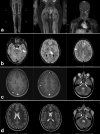Uncovering hidden immune defects in childhood granulomatous disorders: a case report
- PMID: 40755768
- PMCID: PMC12313637
- DOI: 10.3389/fimmu.2025.1634661
Uncovering hidden immune defects in childhood granulomatous disorders: a case report
Abstract
Granulomatous diseases in childhood present a complex diagnostic landscape, particularly when histological and clinical findings overlap with those of systemic inflammatory or histiocytic disorders. A subset of these conditions may represent the clinical onset of inborn errors of immunity (IEI), such as Mendelian Susceptibility to Mycobacterial Disease (MSMD), where atypical or sterile granulomas may obscure the underlying infectious or genetic etiology. Recognition of IEI behind granulomatous diseases can radically alter patient's prognosis and therapeutic management. This report describes the case of a 11-years-old with an initial diagnosis of Rosai-Dorfman disease based on clinical and and histological findings. Following relapse after steroid tapering the diagnosis was revised to sarcoidosis, supported by non-caseating granulomas and compatible laboratory findings. Only after cultures from biopsy specimens revealed Mycobacterium avium complex (MAC), immunological investigations were undertaken, revealing a STAT1 dominant negative deficiency, consistent with MSMD. This report underscores the need of considering IEI in pediatric patients presenting with granulomatous inflammation, especially when clinical course is atypical or refractory to standard immunosuppressive therapies. Early microbiological and immunogenetic assessment is essential to avoid diagnostic delay, prevent inappropriate treatment, and guide targeted antimicrobial therapy.
Keywords: Mendelian susceptibility to mycobacterial diseases; STAT1; innate immunity; interferon-gamma (IFNg); mycobacterium avium complex (MAC); mycobacterium avium complex Mendelian susceptibility to mycobacterial diseases (MSMD); nontuberculous mycobacteria (NTM); sarcoidosis.
Copyright © 2025 Sarli, Quaranta, Canessa, Lodi, Pisano, Buccoliero, Oranges, Sieni, Simonini, Bartolini, Venturini, Galli, Azzari and Ricci.
Conflict of interest statement
The authors declare that the research was conducted in the absence of any commercial or financial relationships that could be construed as a potential conflict of interest. The author(s) declared that they were an editorial board member of Frontiers, at the time of submission. This had no impact on the peer review process and the final decision.
Figures




References
Publication types
MeSH terms
Substances
LinkOut - more resources
Full Text Sources
Research Materials
Miscellaneous

